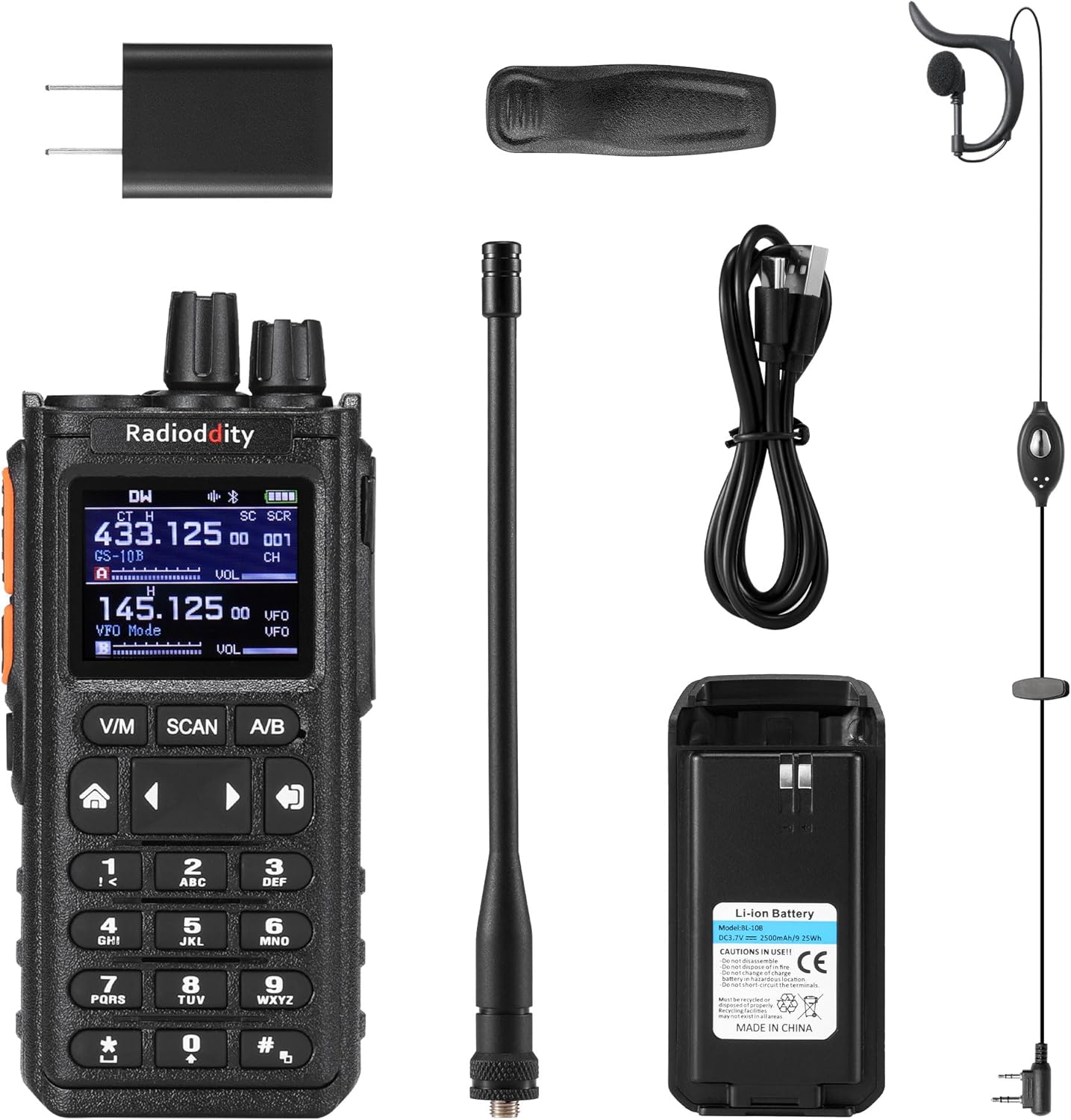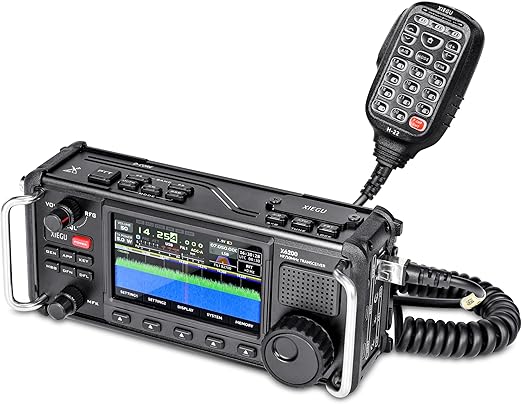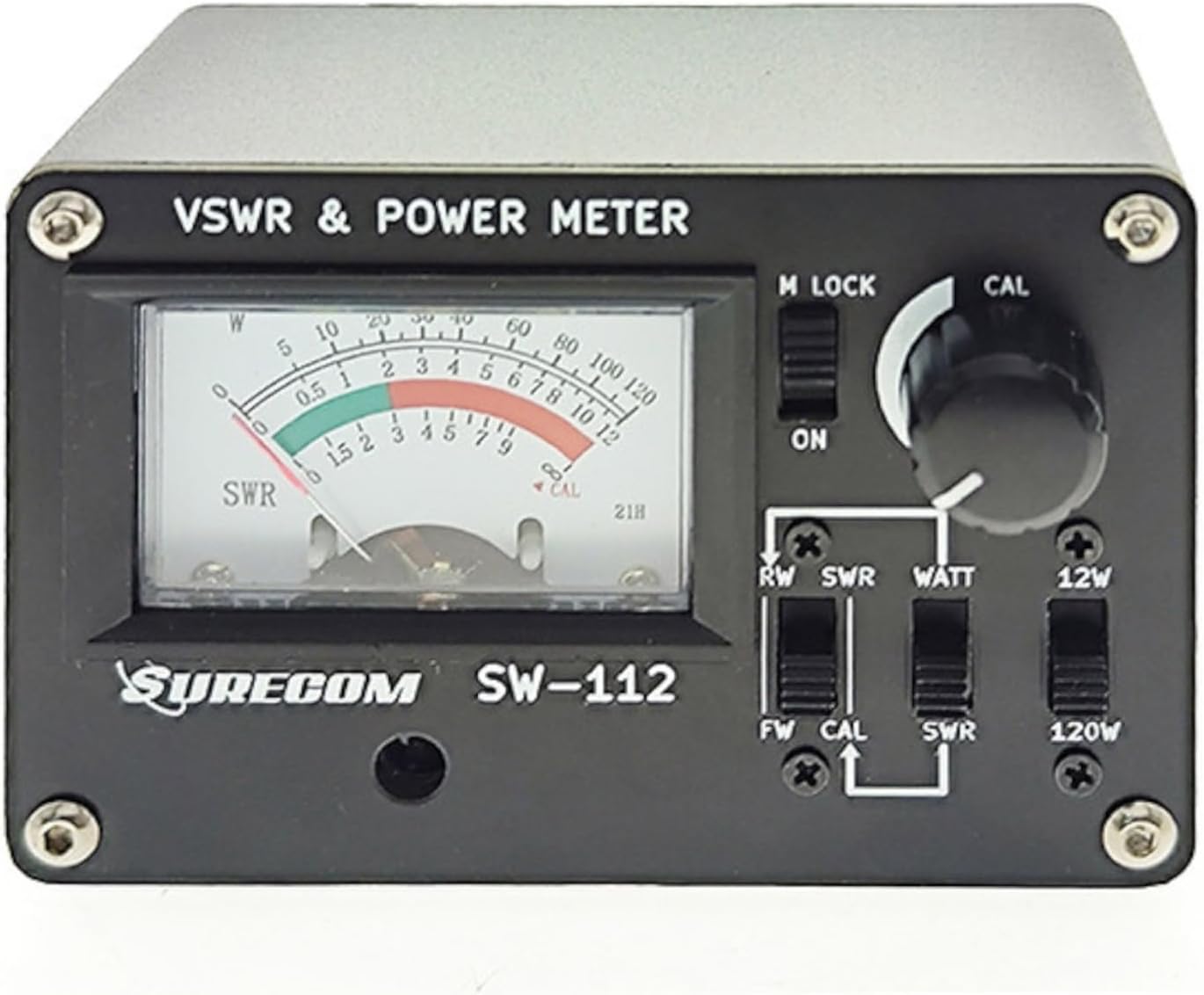
Overview
The Radioddity GS-10B positions itself as a feature-packed, budget-friendly handheld aimed at hams and radio hobbyists who want more transmit power, flexible programming, and modern conveniences like USB-C charging and app control. At its core it’s a dual-band VHF/UHF transceiver with a claimed 10-watt high-power mode, a 2500 mAh battery, dual PTT capability, aviation and NOAA receiver features, and wireless APP programming. In this review I’ll cover design and build, radio performance (receive and transmit), user interface and programming, battery and charging, real-world range expectations, audio and noise handling, accessories and expandability, pros and cons, and who the GS-10B is best for.
Design and build quality
The GS-10B follows the familiar pocket HT form factor but leans slightly toward the robust side. The housing is plastic but feels sturdier than the cheapest no-name handhelds. Controls are conventional: a rotary volume/encoder, a multi-function keypad, PTT on the side, and two PTT buttons for dual-PTT operation. The display is a compact backlit LCD that shows essential information — frequency, mode, battery, and basic status. The keypad legends and labeling are serviceable; they aren’t premium but are clear enough for everyday use.
The battery pack (2500 mAh) attaches to the back with a flush fit and the USB-C port for charging is conveniently placed — a modern touch that simplifies charging compared with older micro-USB-equipped HTs. Antenna thread appears standard SMA or similar (confirm before ordering aftermarket antennas). Overall, the construction is appropriate for the asking price: not indestructible but competent for field use.
Specifications (what matters)
-
Bands: VHF and UHF (typical ham handheld coverage)
-
Power: Up to 10 W transmit in high-power mode (also lower power steps for mid/low)
-
Programming: Wireless app programming plus USB-C wired connection
-
Extra receive: Aviation band and NOAA weather radio receive capability
-
Noise reduction: DSP-based noise reduction or AGC (depending on firmware/implementation)
-
Dual PTT: Two programmable PTTs for different modes/outputs
-
Channel sync: Ability to sync channels between modes or devices (implementation varies)
Because the GS-10B packs 10 watts in a handheld package it occupies a different niche than the common 5 W HTs — more transmit power can help in marginal conditions but comes with tradeoffs in heat and battery drain.
Receive performance
Receive sensitivity on modern budget handhelds is generally acceptable, and the GS-10B’s multi-mode receiver (FM primarily) is competent for local repeater, simplex, and broadcast reception. The inclusion of aviation band and NOAA weather band receive adds practical value for travelers and outdoor users who want situational awareness. Filtering and selectivity are typical for this price class: it will handle strong local signals well enough, but in very crowded RF environments you can sometimes hear overload or intermodulation. The presence of DSP-based noise reduction (if enabled in firmware) helps make weaker signals more intelligible and improves copy in noisy environments.
Transmit performance and power management
The headline is 10 W transmit. That gives the GS-10B an edge over standard 5 W HTs for opening distant repeaters or reaching simplex contacts from less-than-ideal locations. In practice, range improvement is real but not miraculous — doubling power is not the same as doubling range, and propagation plus antenna height dominate. Expect noticeably better performance on line-of-sight links and moderate improvement in obstructed conditions.
Tradeoffs of running 10 W in a handheld:
-
Battery drain: High-power output significantly reduces operating time compared with low-power modes.
-
Audio and modulation: Be mindful to monitor modulation levels and microphone technique — higher output will expose poor audio more readily.

Battery life and charging
The 2500 mAh battery is decent capacity for an HT but not huge, especially when paired with 10 W transmit. In low-power voice use the battery should get a typical day’s casual operating; under heavy use, especially with frequent high-power transmit bursts, expect hours rather than all-day operation. The USB-C port is a welcome convenience — it allows you to use modern chargers and power banks for field charging. A removable battery also means you can carry a spare, which is strongly recommended if you plan to use high-power settings regularly.
Programming and usability — wireless APP and USB-C
Wireless app programming is a major selling point for users who dislike PC cables or want quick field edits. The convenience of programming channels, tones, and names from a smartphone is high, but the actual quality of the app experience depends on Radioddity’s software and firmware implementation. Expect basic functionality: reading/writing channel lists, setting offsets and tones, and perhaps easy import/export of CSV-like data. For bulk editing or advanced features many users still prefer a computer and a conventional programming cable and software — check whether the radio supports common PC CAT or CPS software if you want deep control.
The USB-C port serves dual roles: charging and probably wired programming/data connection. USB-C makes life easier in the field since power banks and modern chargers are ubiquitous.
User interface and ergonomics
If you are used to conventional HTs, you’ll find the GS-10B’s controls familiar. The two PTT buttons provide utility: one can be configured for the main transmit, the other for quick access to a different band, monitor, or auxiliary function. The encoder plus keypad makes frequency entry and menu navigation workable. The display is small but shows essential info; for advanced contesting or heavy scanning it’s not as pleasant as larger-screen radios, but that's a typical compromise in handheld design.
Noise reduction and audio quality
The radio advertises noise reduction which typically means some form of DSP filtering and AGC. In practice this helps on weak signals and when background noise is present. Speaker volume and clarity will depend on the specific speaker design; expect intelligible audio for voice, but do not expect hi-fi. Microphone performance is adequate for normal voice use; consider using a quality external speaker-mic if you want better audio and more durable PTT ergonomics.
Range expectations — realistic outlook
"Long range" is marketing-friendly wording; realistic range depends on many variables:
-
Antenna efficiency and placement (the antenna that ships with the radio matters a lot)
-
Height above ground and obstructions
-
Local terrain (hills, buildings, trees)
-
Repeater line-of-sight
-
Frequency band used (VHF vs UHF)
With a decent antenna and in favorable line-of-sight conditions, expect substantially improved reach using 10 W vs 5 W, especially on VHF. In obstructed urban or dense forest environments the improvement will be smaller. Don’t expect the GS-10B to match mobile or base station setups with full-size antennas and external feedlines — but for a handheld, it offers solid extra punch.
Channel sync and memory features
Channel sync can be handy if you want to clone channels between modes or maintain consistent channel lists across banks. Memory management and channel naming make the radio practical for everyday use. The app programming should make organizing channels quicker than menu-only editing.
Accessories and expandability
Typical accessories to consider:
-
Spare battery(s) to extend field time
-
External speaker-mic for convenience and improved audio
-
Upgraded antenna or SMA adapter if you want to use higher-performance handheld antennas
-
USB-C cable and power bank for field charging
-
Protective case or belt clip for durability
Check compatibility for third-party accessories and antenna connectors before purchasing.
Firmware and community support
Feature-rich handhelds benefit greatly from active firmware updates and community support (third-party programming files, user tips, etc.). Expect incremental firmware improvements over time that can add features or refine behavior. If you value community-driven tips, check active user forums for tips on programming, heat management at 10 W, and recommended accessory combinations.
Who should buy the Radioddity GS-10B?
-
Hams who want more transmit power in a handheld for marginal repeater access or longer simplex hops.
-
Users who value modern conveniences like USB-C charging and smartphone app programming.
-
Outdoor users and travelers who appreciate aviation and NOAA weather receive functionality for situational awareness.
-
Budget-minded operators who want a lot of features without paying top-tier brand premiums.
Who should consider something else?
-
Users prioritizing maximum battery life and small form factor — a 5 W HT will typically last longer per charge.
-
Those who need guaranteed, professional-grade durability or IP water/dust rating — consider ruggedized models from established brands if that’s critical.
Pros
-
10 W transmit option gives a practical edge over typical 5 W HTs
-
USB-C charging is modern and convenient
-
Aviation and NOAA receiving add useful secondary features
-
Dual PTT offers flexible operational modes
Cons
-
10 W increases battery drain and can produce heat under heavy use
-
Build quality is good for the class but not premium
-
App and firmware quality varies by manufacturer and may require updates
-
Real-world range depends heavily on antenna and environment — not a guaranteed "long range" solution in all situations
Practical tips and recommendations
-
Carry at least one spare battery if you plan to run at high power for more than a few hours.
-
Use the lowest power that accomplishes your contact (conserve battery and reduce heat).
-
Invest in a quality external speaker-mic and, if you like, a better handheld antenna for improved performance.
-
Learn the app’s read/write procedure before relying on it in the field — test programming at home first.
-
Be mindful of duty cycle when using prolonged digital modes or long voice transmissions at 10 W.

Final verdict
The Radioddity GS-10B offers an attractive feature set for experimental and practical use: higher-than-usual handheld transmit power, modern conveniences like USB-C and app programming, and extra receive bands that broaden usefulness. It’s a strong choice for hams who want more reach from a portable radio and are comfortable managing the tradeoffs in battery life and heat. For casual users who prioritize battery endurance above all, or for professionals needing extremely rugged hardware, there may be better alternatives. For its price class the GS-10B delivers an excellent combination of functionality and value, especially for those who appreciate the flexibility of app-based programming and the extra oomph of a 10 W handheld.





